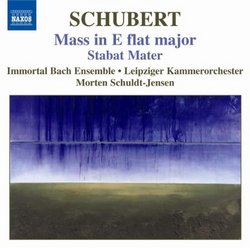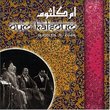| All Artists: F. Schubert, Morten Schuldt-Jensen, Immortal Bach Ensemble, Leipziger Kammerorchester Title: Schubert: Mass in E flat major; Stabat Mater Members Wishing: 0 Total Copies: 0 Label: Naxos Original Release Date: 1/1/2008 Re-Release Date: 2/26/2008 Genre: Classical Styles: Opera & Classical Vocal, Chamber Music, Historical Periods, Classical (c.1770-1830) Number of Discs: 1 SwapaCD Credits: 1 UPC: 747313038176 |
Search - F. Schubert, Morten Schuldt-Jensen, Immortal Bach Ensemble :: Schubert: Mass in E flat major; Stabat Mater
 | F. Schubert, Morten Schuldt-Jensen, Immortal Bach Ensemble Schubert: Mass in E flat major; Stabat Mater Genre: Classical |
Larger Image |
CD DetailsSimilar CDs
|
CD ReviewsSchubert's Last Mass Robin Friedman | Washington, D.C. United States | 03/31/2008 (5 out of 5 stars) "Schubert's Mass in E-flat major, D.950, the last of his six works in this form, is a product of the final months of his short life. Even though the form of the work is traditional, the e-flat major mass is a deeply personal idiosyncratic work which Schubert composed knowing his own death was near. The mass has been compared by many in its place in Schubert's life to Mozart's Requiem. The mass also is a statement of Schubert's own religous convictions, as he altered the text of the traditional mass to remove himself from traditional Roman Catholic theology in favor of an approach to God that many today would describe by the term "spiritual". Unfortunately, this otherwise excellent budget-priced CD does not include the traditional mass text or Schubert's emendations. But the music sings through.
Morten Schuldt-Jensen conducting the Leipziger Kammerorchester and the Immortal Bach Ensemble offer a beautifully radiant performance of the mass. Schuldt-Jensen and his ensemble have been active of late in their records for Naxos, which include Haydn's Creation, Mozart's Requiem, and a collection of vocal music by Domenico Scarlatti. The choir and the orchestra capture both the lyricism and power of Schubert's score. The soloists have a small part in this mass , but the performance of the two tenors and the soprano (sometimes, but not in this recording, sung by a boy) in the "et incarnatus est" section of the trio complements the orchestra and choir. The e-flat major mass includes sections of great contrasts. Lyrical sections alternate with moments of power and drama in the "Domine Deus" section of the Gloria, in the "Crucifixus" section of the Credo, and in the Benedictus. The melodies are flowing, chromatic, and digressive. Late in his life, Schubert began a serious study of counterpoint, and the results of his efforts can be seen in this mass. The final sections of the Gloria and the Credo consist of lengthy powerful fugues that show how far Schubert had progressed in mastering this form. The combination of trombones, brass, and tympani have a large role throughout the mass and bring to it a feeling of solemnity. The work ends on a moment of peace in the final "dona nobis pacem." The filler on the CD is Schubert's brief "Stabat Mater" D. 175 written when the composer was eighteen. This early work shares some of the lyricism and drama of its much later successor. For those listeners who know Schubert through his songs, symphonies, and chamber and piano works, this CD will offer a revealing portrait of Schubert as a composer of moving liturgical music. total time: 51:59 Robin Friedman" |



